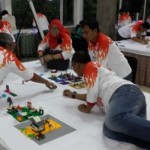LSP for the classroom
Tagged: engagement, Facilitation, innovation, Square Wheels, Teambuilding
- This topic has 8 replies, 6 voices, and was last updated 6 years, 2 months ago by
 Scott Simmerman, Ph.D. CPF, CPT.
Scott Simmerman, Ph.D. CPF, CPT.
-
AuthorPosts
-
May 12, 2018 at 11:49 pm #11530
Joy Sasser
ParticipantIt seems much of LSP is geared to adults which is awesome. One problem I have found with LEGO Ed geared toward kids is that it is all STEM oriented. Hopefully we will eventually get there but we are at the starting block of problem solving. Years ago I had an early addition of Story Starter Set (discontinued) which is more along the lines of LSP. Now I will be going to Tanzania to work with Teachers and students on problem solving through creative and critical thinking using literature. I want to use LEGO to flesh out story elements and then we will also be using LEGO with Escape Room challenges to build general problem solving puzzles. This is all in my head at this moment. I am looking for some good LSP team building problem solving games that can also be used first with the teachers and then with the kids. The big Identities and Landscapes kit would be perfect but I would need to find a donor for our charity. So until we have that kind of extra funding it will need to be done with either self made kits or multi brick boxes that are easier to buy.
So my question before I order the new book is, does the new book give lots of activity ideas or is so geared to corporate world that it wouldn’t be that adaptable in a classroom? Are there other activity and basic design ideas available for download? Does the LSP starter kit guide have enough build ideas to create animals and storylines?
Thank you,
JoyMay 13, 2018 at 11:30 am #11537Koen van Sabben
ParticipantHi Joy,
The classroom version of LSP was: buildtoexpress (indeed discontinued also)But the material / guides is still available :
https://education.lego.com/en-us/support/buildtoexpress/curriculum-download-supportThis could be a good starting point.
Good luck.Koen
May 14, 2018 at 11:01 pm #11542Joy Sasser
ParticipantKoen,
Thank you for the link. I have downloaded it and have begun to look through it for ideas. I have to admit that looking at the challenges I wasn’t sure I knew how I would respond or what I would build. The questions were good, but how do you in corporate settings get adults who haven’t played with LEGO before or not in 30 years to figure out how to convey ideas into bricks? I see my kids do it, but they have played with them since they were very little. I am guessing the classroom model got discontinued because, although it is well designed and conceptually it is perfect, teachers need to go through the facilitators training and there is no money for that and the cost of the bricks. I am going to keep working on this… :)
Thanks again,
Joy
May 17, 2018 at 8:15 am #11575 SebastianParticipant
SebastianParticipantHi Joy,
In answer to you questions “..how do you in corporate settings get adults who haven’t played with LEGO before or not in 30 years to figure out how to convey ideas into bricks?”;
I have been doing LEGO SP in corporate settings for several years now with thousands of participants.. staff level, middle managers, Board of Directors, Minsters etc. Ages ranging from early 20s to late 60s, both from Western and Eastern Cultures. I have found that actually using LEGO is one of the easiest tools to communicate and express ideas for people who normally have difficulties doing it in normally ways such as Seminars, presentations, group discussion, etc.
The adult vs kids comfort levels in communicating and building ideas are actually done away with very quickly.. normally within the first 30 minutes to an hour.
I have had maybe 2 failures to engage adults.. in both cases the participant had what I can only call Spatial Dyslexia.. they have a problem with LEFT vs Right and UP vs Down when handling objects.
Apart from that LEGO SP is the easiest way I have found for adult to engage in learning (within Conceptual bounds).
I am sure all other practitioners here will say the same
May 18, 2018 at 12:06 pm #11590Ed Chester
Participantfully agree. the idea of make a physical metaphor is the easy part. everyone i’ve worked with has been fully on board with putting abstract concepts onto bricks after about 45mins, 3/4 of the way through the standard skills building. if you don’t do the skills building, you can’t expect the method to work.
May 18, 2018 at 12:38 pm #11591 Eli De FriendModerator
Eli De FriendModeratorI won’t bother to repeat what Sebastian has already said, but will be a bit more rhetorical. How did we learn that the shapes (that we call letters) “d” “o” “g” represent a four legged mammal with a tail that it wags when it’s happy and that those same shapes/letters in a different sequence represent the supreme element of our belief system? As adults, if we see a zig-zag line going from bottom-left to top-right, we assume that sales are basically going up, until we read that the Y axis is the number of customer complaints per sale or that the X axis represents the amount of money invested and the Y axis represents the degree of depreciation of share value. In other words, adults have been trained to use metaphors and symbols all the time. We never call a “spade” “a spade”. So why would we have any difficulty understanding that a cube built solely of standard black bricks might represent some technology that we don’t need to know about or more specifically some fault diagnostic tool analogous to those found in aeroplanes? We might even accept the same representations, even if the builder explains “I couldn’t find any black bricks, so I used white bricks. But can you just imagine that this is a black box that records everything that goes wrong”.
I have never understood why, during the early days of LSP, there was this assumption that adults are incapable of using metaphor. We use metaphors and story telling all the time. And management consultants have been using LEGO bricks in Board Rooms since the early nineties. LSP, it would appear, could be considered rather old, mainstream technology, when you think about it :-)May 18, 2018 at 5:18 pm #11601Joy Sasser
ParticipantPlease don’t think I was suggesting that I doubted adults could learn this way. I am trying to wrap my head around how to walk through some of these steps and looking for tips that you have found helpful in moving first time users from physical concepts to more abstract. It is easier to show for examples a theme of generosity than to show a theme of trust. Not at all that this can’t be done, but how have you helped first time users make the transition into abstract concepts.
I would love to hear some examples of abstract concepts you have had users process and build, what steps you took to inspire the abstract thinking, and what were the results or ways they used displayed those concepts through bricks.
May 19, 2018 at 8:38 am #11604 SebastianParticipant
SebastianParticipantEli had a very good explanation of how humans (kids and adults) process metaphors. Incidentally I also do workshops with children from ages 4 (speaking age) to early teens and I have found that their grasp of understanding, modelling and explaining metaphors through LEGO (or any other physical object) is generally the same as adults. It is just a matter of reference subject matter that is different.
In fact in corporate client testimonials a common comment is: “We were quite worried and hesitant in the beginning as to how we as directors, managers would be able to use the tools productively and be engaged with children’s toys. Instead we found that we quickly become like children and started building metaphors and discussing them and found that we became very creative and issues emerged beyond our expectations” (I am summarizing and paraphrasing here).
I am always worried at the beginning of every workshop, usually because I get infected by the HR people who retained me and who are worried they may be gambling money on an unorthodox methodology and get reprimanded. However after 100’s of workshops I have yet to have even one workshop fail where adults could not build and discuss metaphors of simple or complex issue.
Eli may be able to better explain the scientific basis for why it works but I just generally tell the client ” I’m not really sure why it works, but it normally does… just trust me and my experience with other clients”. I then give them the contact of the other clients (with permission) to verify.
Regarding concepts whether it is modelling Truth, Leadership, Government Corruption, Why Mummy and Daddy have to Work, What is God, Integrity, Inefficient Systems, Life Goals, The Meaning of Life, Inter Departmental Budget or Strategy Alignment, Innovation and Disruption in Brands and Products… we’ve covered them all and they all worked.
The approach I use is to normally to:
1. explain the 4 Core Steps,
2. get them to build something simple (a bridge, a tower) in the skills building phase
3. Modify their simple model into another concept (Leadership, Customer Service, Integrity)
4. If some participants seem hesitant or confused I just tell them: ” Don’t think about it, don’t plan it, just get the bricks and start building, your hands will figure out what to do. You may not understand what you have built but when you start sharing and touching the model, the ideas will come to you.I know it sounds simplistic and rather unscientific but it works 99% of the time. Also remember there are other participants quicker on the uptake and act as role models for the others.
Cheers!
May 19, 2018 at 5:08 pm #11605 Scott Simmerman, Ph.D. CPF, CPTParticipant
Scott Simmerman, Ph.D. CPF, CPTParticipantIt is REALLY EASY to engage people if you are doing things WITH THEM rather than TO them. And general metaphors work great if you allow the participants to reframe them into something personal to the individual or tabletop.
Show someone a Rorschach (inkblot) image and they will see things. Show them a construct from something like a Thematic Apperception Test (find examples online) and they will project context and intention.
Give them LEGO and they will bridge to anchoring to some storyline or situation or solve a problem.
For 25 years, I have been showing a line art illustration of a wagon being pulled by someone and pushed by others, with the wagon rolling on Square Wheels® and the cargo being round tires. Hell, I so not even introduce myself, just stepping up to the front and showing that image and asking tabletops of 5 to 6 people to play with the theme, “How might this image represent how things really work in most organizations?”
When I was doing conferences (47 countries), my sessions would ALWAYS be the top-rated ones. People have no problems engaging in metaphor and in relating things to their own issues and opportunities. People WANT active involvement and self-learning; they want the ideas to be related to them, not some abstract.
I am guessing that a LOT of us LEGO facilitators now find it IMPOSSIBLE to sit in on some lecture unless the presenter is very attractive — when I do, I find myself doodling and outlining and playing with MY issues on my notepad. I cannot remember the last thing I learned from being lectured at…
-
AuthorPosts
- You must be logged in to reply to this topic.

 Become a LEGO Serious Play facilitator - check one of the upcoming training events!
Become a LEGO Serious Play facilitator - check one of the upcoming training events!